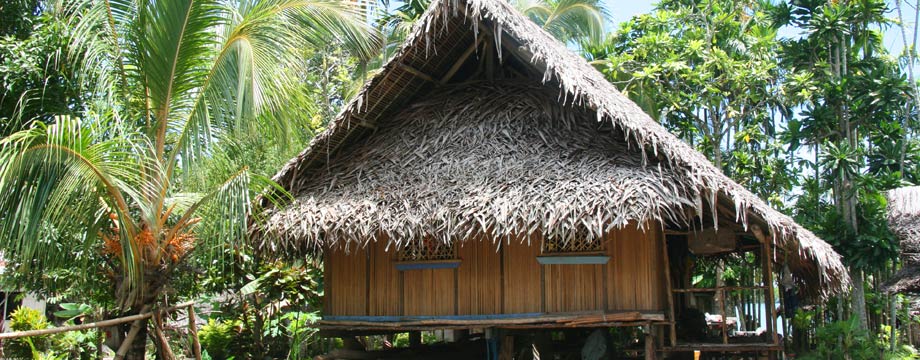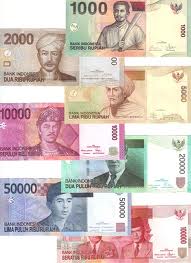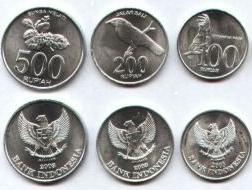As anyone traveling to a new country may tell you; if you know the language, you are good to go. The reality is that oftentimes, we travel to new places and only know very little of the language or sometimes, nothing at all. Not to fear! In our experiences in Indonesia [with very little Indonesian knowledge] we were still able to have a superb time. Tourism in Indonesia is a big draw and a big business, so many Indonesians know at least some English. As mentioned in the previous post on where Indonesia is in the world, Indonesians are required to take English in school… so many of them know at least some of the language. Additionally, in places such as Bali, where tourism is paramount, many people go to school specifically to work in the tourism industry, so they too, know English. But I digress, back to language in a bit. Let’s start with money.
Money
Indonesian currency is called “Rupiah” [roo-pee-ah]. As of May 2014,
1 Rupiah = $0.000087 USD
1 Rupiah = $0.000052 British Pounds
1 Rupiah = $0.000093 Australian Dollars
1 Rupiah = $0.0089 Japanese Yen
1 Rupiah = $0.00011 Singapore Dollars
For more information on exchange rates visit this site.
Indonesian Rupiah are extremely colorful and come in both bills and coins. The smallest bill that we have encountered is the 1000 rupiah. Coins are typically smaller denominations and although I recently read a website stating that it is possible to get a 100,000 rupiah coin, I have never seen larger than a 500 rupiah coin.
The bills come in 1,000; 2,000; 5,000; 10,000; 20,000; 50,000; and 100,000 rupiah. Based on the conversation rates to USD, a 100,000 rupiah bill is around $10.
The rupiah coins that you most often see are 100, 200, & 500 rupiah:
When you arrive in Indonesia, remember that you must pay $25 US for an on arrival visa. This can also be paid in rupiah if you happen to have it; we always make sure to carry US dollars with us just in case. So, we typically pay on arrival visa fees with that money.
You may choose to exchange money before you arrive in Indonesia. You may also choose to exchange money once you arrive. We simply take money out of an ATM in the airport. This just seems to be easier for us. While you do have to pay a transaction fee, it is typically smaller than the cost of exchanging through a booth. The downside is that there is a maximum on how much you can take out of the ATM at any one time [around Jakarta we found this to be between 1,000,000 and 2,500,000 rupiah or roughly $100-$250]. Depending on your plans, this may or may not work for you. For us, it worked perfectly.
If you are planning to go on an excursion of some sort and you book through the guide itself or a local Indonesian group, you will oftentimes have to pay the remaining balance in cash when the excursion begins. Because of this, taking money out of an ATM sometimes doesn’t get you the amount that you need, so be sure to keep that in mind based on your plans.
Many places in Indonesia take credit cards, especially when you are traveling to larger or more tourist-like destinations such as downtown Jakarta [a mall, for example] or main areas of Bali. However, note that taxis do not take credit cards and smaller restaurants do not either. So, it is always good to have some money on hand and if possible, get some smaller bills as well [purchase a drink to break larger bills].
Food and drink prices are typically a lot less than you would see in places like the US and obviously, if you choose to eat from a street cart instead of in the mall, you’ll be spending less money as well. As an example, there is a Coffee Bean and Tea Leaf [yes i know, not Indonesian at all] in the mall under the hotel we stayed in when in Jakarta. We purchased an iced coffee and an iced latte and the total was 74,000 rupiah [over $7!]. In comparison, every day that we ate lunch near Andrew’s office, we paid 100,000 rupiah [$10] for two entrees, 2 bottles of water, 2 coconut shakes, and a coconut water with coconut meat in it.
A final note on money in Indonesia- there is no tipping. Service industry employees typically are paid well [in comparison with those in the US at least] and the few times we’ve tried to tip, the recipients tried to turn it down!
Language
As previously mentioned, depending on where you are traveling in Indonesia, knowing the local language [Bahasa Indonesian] isn’t all that necessary, although you will obviously have a much easier time getting around if you do know at least a little Bahasa. In much of Bali, we had no problem getting around without Bahasa. In Jakarta, the main malls were fine with English, the smaller areas and the taxi drivers were not as good with English. For that reason, it is good to at least write down and practice a few words and/or phrases in Bahasa if you are planning to travel in Indonesia. For example, I do not like seafood. I loathe it. Unfortunately, much of this part of the world lives on it. So, I made sure to look up and write down a few words and phrases so that I could at least say “no seafood” or “vegetables please”, etc. *Note- if you are planning on taking taxis around an area such as Jakarta, it is helpful to have the address written down and a map with the location. To help with this, if you have your Smartphone, you can take a snapshot of the location on your map while you have wifi and save it to your phone so you can show your driver.*
Here are a few phrases that are good to know:
1– Satu (sah-two) 2– Dua (doo-ah) 3– Tiga (tee-gah) 4– Empat (um-pot) 5– Lima (lee-mah)
6– Enam (ahn-um) 7– Tujuh (two-joo) 8– Delapan (del-ah-pan) 9– Sembilan (som-be-lan) 10– Sepuluh (sep-oo-loo)
Hi/Hello– Halo (hollow)
Thank You– Terimah kasi (tare-reem-ah kahs-see)
Good Morning– Selamat pagi (sla-maht pog-ghee) For other parts of the day use “Selamat” with the appropriate word:
Afternoon: Sore (sore-ay)
Evening/Night: Malam (mahl-ahm)
Yes– Ya No– Tidak
Right: Kanan (kahn-non) Left: Kiri (key-ree) Straight: Lurus (loo-roose)
Here: Di sini (dee scene-ee) There: Di sana (dee sahn-nah)
This: Ini (een-knee) That: Itu (eat-two)
I would like: Saya minta (Sigh-ah mean-tah)
Water: Aire (ire) *Also called “aqua botol” (ah-quah boat-toll)
Fish: Ikan (eek-ahn) Chicken: Ayam (eye-ahm) Vegetables: Sayur Sayuran (sigh-your sigh-your-ahn)
Fried: Goreng (gore-ang) Roasted: Panggang (pong-gong)
Noodle: Bakmi (bock-me) or just Mie (me) Rice: Nasi
Additionally, here are a few apps that we found especially helpful for translating from English to Bahasa (free and available on IPhone):
1. Kamusku (Free): An offline Indonesian-English dictionary
2. Learn Indonesian (Free with option to upgrade for $5.00): A fun little app with categories that you would use/need to get around (greetings, general conversation, numbers, directions/places, transportation, eating out, etc.) The $5.00 upgrade will get you more detailed items like colors, family, dating, and feeling sick.


